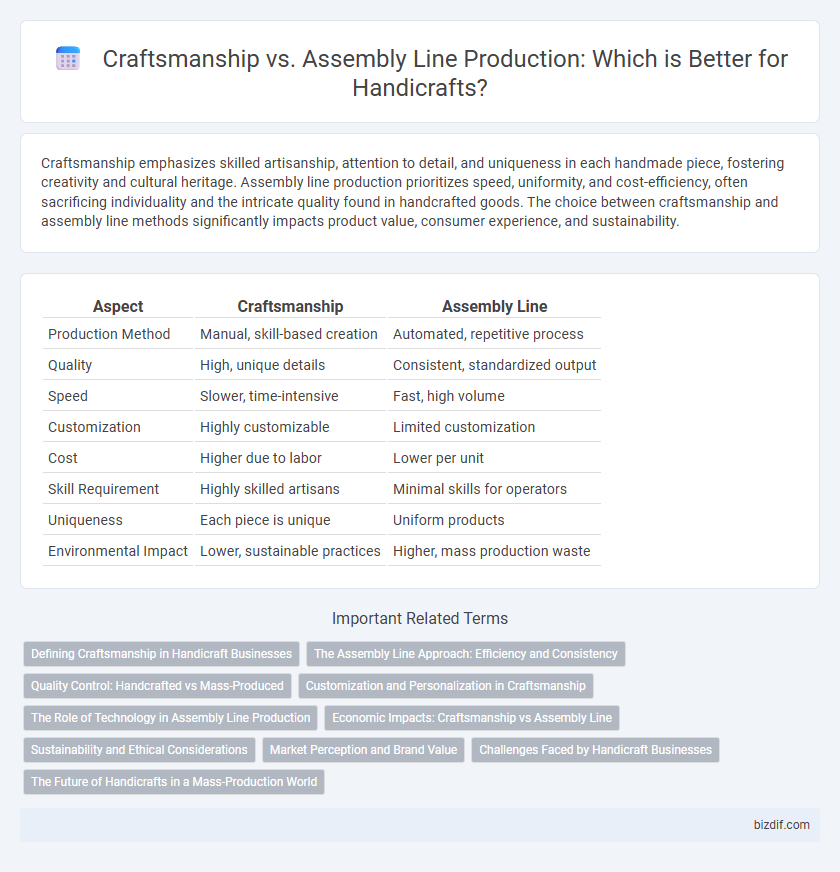Craftsmanship emphasizes skilled artisanship, attention to detail, and uniqueness in each handmade piece, fostering creativity and cultural heritage. Assembly line production prioritizes speed, uniformity, and cost-efficiency, often sacrificing individuality and the intricate quality found in handcrafted goods. The choice between craftsmanship and assembly line methods significantly impacts product value, consumer experience, and sustainability.
Table of Comparison
| Aspect | Craftsmanship | Assembly Line |
|---|---|---|
| Production Method | Manual, skill-based creation | Automated, repetitive process |
| Quality | High, unique details | Consistent, standardized output |
| Speed | Slower, time-intensive | Fast, high volume |
| Customization | Highly customizable | Limited customization |
| Cost | Higher due to labor | Lower per unit |
| Skill Requirement | Highly skilled artisans | Minimal skills for operators |
| Uniqueness | Each piece is unique | Uniform products |
| Environmental Impact | Lower, sustainable practices | Higher, mass production waste |
Defining Craftsmanship in Handicraft Businesses
Craftsmanship in handicraft businesses emphasizes skilled, artisanal techniques that produce unique, high-quality products often reflecting cultural heritage. Unlike assembly line production, craftsmanship involves meticulous attention to detail and personalized touch, ensuring each piece embodies creativity and authenticity. This artisanal approach fosters sustainable practices and supports local economies by valuing human skill over mass manufacturing.
The Assembly Line Approach: Efficiency and Consistency
The assembly line approach revolutionizes manufacturing by maximizing efficiency and ensuring product consistency through standardized processes and repetitive tasks. This method reduces production time and labor costs, enabling mass production of uniform goods. Advanced automation and quality control systems further enhance precision and minimize human error in assembly line operations.
Quality Control: Handcrafted vs Mass-Produced
Handcrafted products undergo meticulous quality control through skilled artisans who inspect every detail, ensuring unique imperfections that enhance authenticity. Assembly line production relies on standardized processes and automated inspections to achieve consistency but may lack the nuanced precision of individual craftsmanship. The contrast in quality control highlights the superior attention to detail found in handcrafted items versus the efficiency-driven uniformity of mass-produced goods.
Customization and Personalization in Craftsmanship
Craftsmanship enables unparalleled customization and personalization, allowing artisans to tailor each piece to individual preferences, materials, and intricate details that mass-produced assembly line products cannot replicate. Handcrafted items reflect unique artistic expression and meticulous attention, often resulting in higher quality and emotional value. This personalized approach fosters stronger customer connections and satisfaction, setting craftsmanship apart in a market dominated by uniform, standardized goods.
The Role of Technology in Assembly Line Production
Technology in assembly line production revolutionizes efficiency by automating repetitive tasks and ensuring consistent product quality. Advanced machinery and robotics streamline processes, reducing human error and speeding up output compared to traditional craftsmanship. This integration of technology enables mass production at scale, meeting high consumer demand while maintaining standardized specifications.
Economic Impacts: Craftsmanship vs Assembly Line
Craftsmanship drives economic value through unique, high-quality products that command premium prices and support local artisans, fostering community sustainability and cultural preservation. Assembly line production boosts economic efficiency by enabling mass manufacturing, reducing costs, and increasing output to meet large-scale demand. The trade-off lies in balancing artisanal skills that enhance product differentiation with the scalability and affordability offered by automated assembly lines.
Sustainability and Ethical Considerations
Craftsmanship emphasizes sustainable practices by using locally sourced materials and minimizing waste, contrasting with assembly line production, which often relies on mass-produced components with higher environmental footprints. Ethical considerations in craftsmanship include fair wages and preserving cultural heritage, while assembly lines may prioritize efficiency over worker conditions and social responsibility. Supporting handcrafted goods fosters environmentally conscious consumption and upholds ethical labor standards.
Market Perception and Brand Value
Handicraft is perceived as embodying superior craftsmanship, with unique, high-quality products that enhance brand value through authenticity and exclusivity. In contrast, assembly line production often emphasizes efficiency and uniformity, which may dilute perceived quality and reduce emotional connection with the brand. Consumers increasingly associate artisanal craftsmanship with premium pricing and sustainable brand positioning, driving market demand for handcrafted goods.
Challenges Faced by Handicraft Businesses
Handicraft businesses face significant challenges competing with assembly line production, including higher labor costs and longer production times that limit scalability and profit margins. Maintaining quality and preserving traditional craftsmanship skills require intensive training and dedication, which are difficult to standardize compared to automated processes. Market demands for lower prices and faster delivery further pressure artisans, making it challenging to sustain handcrafted exclusivity in a mass-produced environment.
The Future of Handicrafts in a Mass-Production World
Handicrafts emphasize meticulous craftsmanship, showcasing unique artistry and cultural heritage that mass-production assembly lines cannot replicate. As automation advances, the future of handicrafts lies in blending traditional skills with modern technology to create personalized, high-quality products. Preserving handcrafted techniques supports sustainable practices and caters to growing consumer demand for authenticity and exclusivity.
Craftsmanship vs Assembly Line Infographic

 bizdif.com
bizdif.com